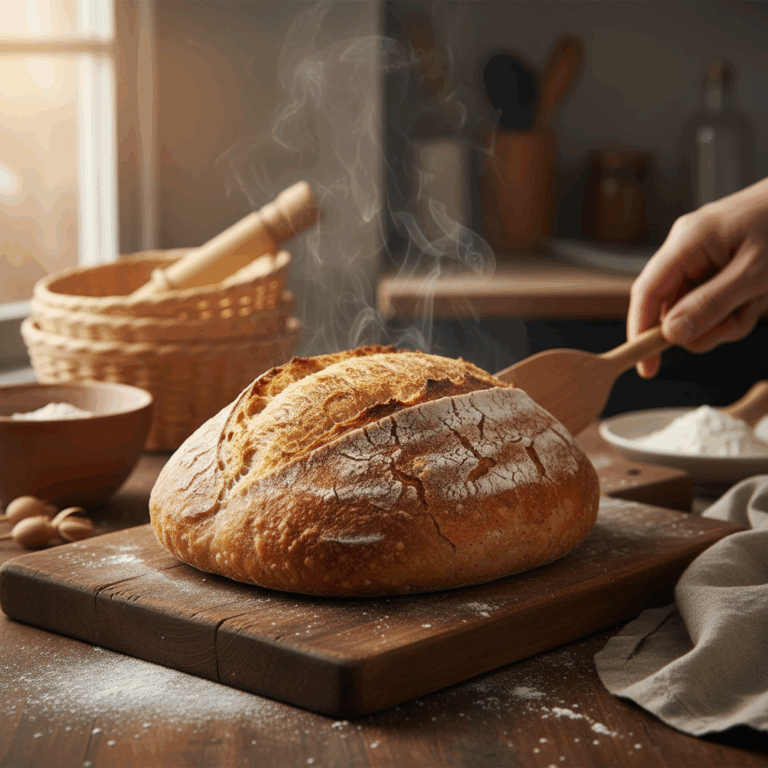Slow fermentation in artisan bread
Slow fermentation is the heart of artisanal bread, marking a key difference from rapid industrial processes. This traditional method preserves the bread's original flavor and nutritional properties.
This process can take between 24 and 48 hours or more, allowing the dough to rest and ferment slowly. This develops complex flavors and a unique texture that characterizes quality artisanal bread.
During this time, the natural action of yeasts and bacteria transforms the dough into a more digestible and healthy food, thanks to the biological activity that occurs at each stage of fermentation.
Fermentation process and duration
The slow fermentation process involves letting the dough rest so that the yeasts and bacteria can work naturally. The duration varies but is usually between 24 and 48 hours.
This extended time allows for complete fermentation, where starches and sugars are broken down, facilitating digestion and improving the texture of the bread, resulting in a superior final product.
Furthermore, this slow fermentation contributes to the formation of intense aromas and flavors, as the biochemical reactions develop with greater depth and complexity.
Role of sourdough and natural microorganisms
Sourdough is essential for slow fermentation; it contains yeasts and bacteria that act on the ingredients without the need for chemical additives. This ensures a more natural and healthy bread.
These microorganisms produce lactic acid which acidifies the dough, helping to preserve the bread for longer and improve its flavor and texture naturally.
In addition, sourdough helps neutralize compounds such as phytates, facilitating the absorption of essential minerals for health, which increases the nutritional value of artisanal bread.
Health benefits of slowly fermented bread
Slow fermentation significantly improves the digestibility of artisanal bread, reducing food intolerances. This process transforms hard-to-digest components into substances more readily available to the body.
In addition, it allows sugars and gluten to be partially broken down, decreasing the likelihood of digestive discomfort and facilitating the assimilation of nutrients in sensitive people or those with digestive problems.
Improved digestibility and reduced intolerances
During slow fermentation, lactic acid bacteria act on gluten and other compounds, breaking them down into simpler fragments. This reduces the immune response that causes intolerances.
The resulting bread is gentler on the digestive system, allowing people with gluten sensitivity to have better tolerance without sacrificing the traditional taste or texture.
This improvement helps make artisanal bread a suitable option for those seeking more natural and less processed foods, with clear benefits for gastrointestinal health.
Decreased glycemic load and metabolic effects
Prolonged fermentation helps reduce the glycemic load of bread, meaning that the rise in blood sugar is slower and more controlled. This is crucial for preventing abrupt blood sugar spikes.
This beneficial effect is especially relevant for people with diabetes or insulin resistance, helping to maintain healthy glucose levels and improving metabolic control.
In addition, the lactic acid generated during fermentation improves the glycemic index of the bread, promoting a more stable energy supply over time.
Increased bioavailability of minerals
The sourdough used in slow fermentation breaks down phytates, compounds that inhibit the absorption of essential minerals such as iron, zinc, and calcium. This increases the availability of these minerals to the body.
This process gives artisanal bread a superior nutritional value, promoting better bone, immune, and metabolic health thanks to the greater absorption of nutrients.
Therefore, slowly fermented bread is not only delicious, but also a more efficient source of vital minerals for the body, improving daily nutrition.
Organoleptic characteristics of artisanal bread
Artisan bread is distinguished by its organoleptic qualities, a direct result of slow fermentation and the use of sourdough. These characteristics affect its flavor, aroma, texture, and appearance.
These sensory attributes not only make the bread more delicious, but also offer a unique experience that invites you to enjoy every bite with attention and appreciation.
The combination of traditional techniques and long fermentation times gives artisan bread its distinctive identity in the world of baking.
Development of complex flavors and aromas
During slow fermentation, chemical compounds are generated that develop deep and complex flavors, much richer than those of industrial bread. These flavors can include acidic, sweet, or even fruity notes.
The microorganisms present in the sourdough produce acids and alcohols that enrich the aroma and flavor, giving the artisan bread an irresistible fragrance and a unique character.
The result is a bread with a balanced and sophisticated taste profile, capable of standing out with just one bite, making each portion memorable for the consumer.
Crumb and crust texture
Artisan bread has an alveolated, spongy and moist crumb, derived from the slow fermentation that allows the optimal development of the gluten structure and carbon dioxide.
The crust, on the other hand, is crispy and golden, providing a pleasant contrast with the soft interior and a tactile sensation that is highly appreciated on the palate.
This duality between crust and crumb is a clear sign of quality and craftsmanship, which differentiates traditional bread from mass-produced bread.
Cultural and nutritional importance of artisanal bread
Artisan bread represents much more than just food; it's a symbol of cultural identity and culinary traditions passed down through generations. Its preparation respects ancestral values.
Furthermore, this bread provides superior nutrition compared to industrial products, due to its slow fermentation and use of natural ingredients, promoting a healthier and more mindful diet.
This combination of history and science makes artisanal bread a bridge between past and present that promotes a better quality of life.
Rescue of ancestral breadmaking techniques
The making of artisanal bread revives traditional processes that had been lost with industrialization. Ancestral techniques such as the use of sourdough and slow fermentation are being recovered.
This strengthens cultural knowledge and preserves local gastronomic diversity, linking communities with their roots and customs through the practice of these techniques.
The care taken at each stage reflects the symbolic and social value of bread as a unifying element and intangible heritage of numerous cultures.
Commitment to health and natural nutrition
Artisan bread aligns with a holistic approach to health, prioritizing natural ingredients and processes that maximize the nutritional value and digestibility of the product.
The absence of chemical additives and preservatives, along with prolonged fermentation, contribute to creating a more balanced food, ideal for those who value a natural diet.
This commitment responds to the current demand for food options that combine quality, authentic flavor, and sustainable health benefits.







